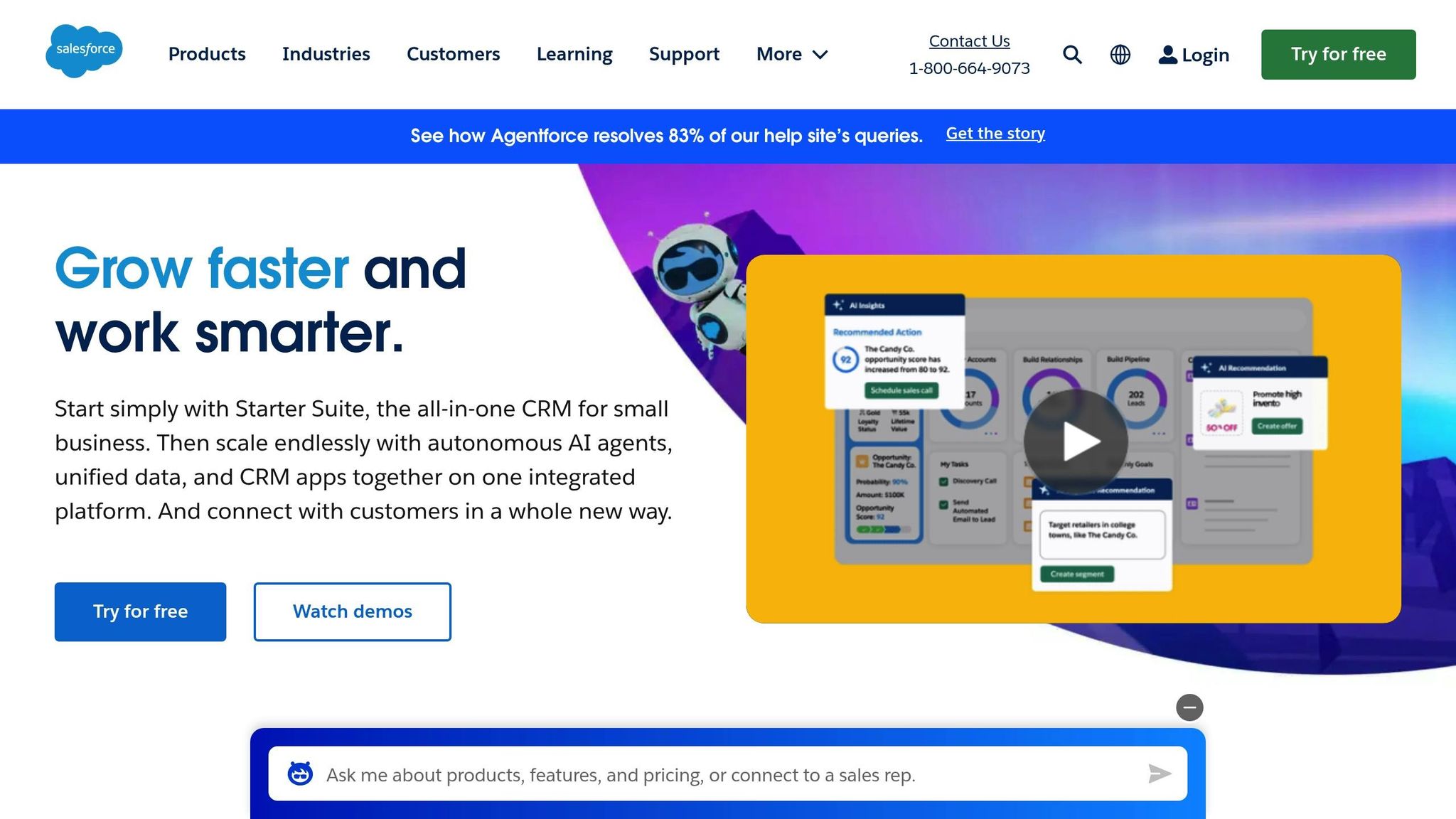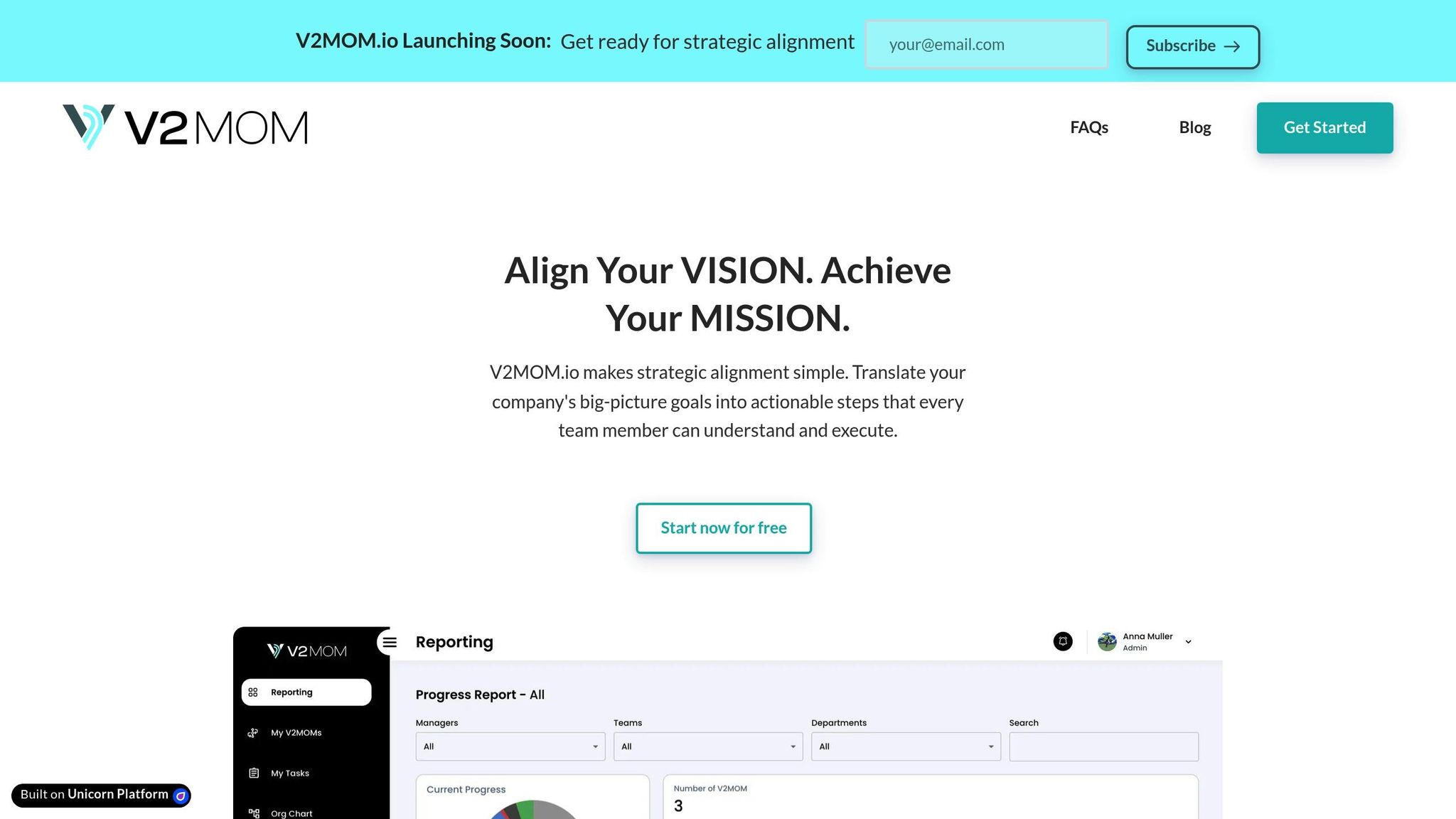Strategic alignment is essential for organizational success, yet many companies struggle with it. Here’s a quick breakdown of the key challenges and solutions:
Key Problems
- Vague Vision and Goals: Leads to confusion, conflicting objectives, and low motivation.
- Disconnected Teams: Silos hinder collaboration, waste resources, and delay decisions.
- Competing Priorities: Too many initiatives dilute focus and derail execution.
- Inflexible Planning: Rigid methods fail in fast-changing environments.
Proven Solutions
- V2MOM Framework: Define vision, values, methods, obstacles, and measures for clarity and focus.
- Better Communication: Use shared tools, transparency, and regular reviews to break silos.
- Data-Driven Decisions: Set clear KPIs, integrate data platforms, and adapt based on performance.
Aligned organizations achieve up to 58% higher revenue growth and 72% better margins. Start by linking daily tasks to strategy and tracking progress regularly for measurable results.
V2MOM: The Salesforce Management Process

Key Alignment Problems
Only 22% of employees strongly agree their company's leaders have a clear direction [2]. Let's break down four major challenges that hinder proper organizational alignment.
Vague Vision and Goals
When a company's vision and goals are unclear, confusion spreads across the organization. This often leads to:
- Teams working toward conflicting objectives, wasting time and resources.
- Difficulty in tracking progress and defining success.
- Lower employee motivation and engagement.
Disconnected Teams
Cross-functional collaboration is essential for success. Companies that excel in this area are 5.5 times more likely to be high-performing organizations [6]. When teams operate in silos, the consequences include:
- Missed opportunities for innovation due to lack of collaboration.
- Duplicated efforts that waste valuable resources.
- Inconsistent experiences for customers.
- Delayed decision-making processes.
Too Many Competing Priorities
Trying to juggle multiple strategic initiatives without clear focus can derail execution. In fact, only 30% of companies meet their strategic goals [5]. Common conflicts arise from goals such as:
- Expanding into new markets while cutting costs.
- Balancing quality improvements with faster production.
- Managing digital transformation alongside operational stability.
Inflexible Planning Methods
Rigid planning doesn't hold up in today’s fast-changing business landscape. Agile organizations are 70% more likely to rank in the top quartile of organizational health [4]. Inflexible planning leads to:
- Missed opportunities and slower responses to change.
- Reduced ability to innovate.
- Falling behind competitors.
These challenges weaken overall performance and call for structured solutions. We'll dive into proven frameworks to address these issues in the next section.
Solutions for Better Alignment
To overcome the four barriers discussed earlier, organizations can implement these three interconnected strategies:
Using V2MOM Methods
The V2MOM framework offers a clear structure for strategic alignment. It breaks planning into five essential components:
| Component | Purpose | Outcome |
|---|---|---|
| Vision | Define where you want to go | Provides clear direction |
| Values | Establish priorities | Guides decision-making |
| Methods | Outline the approach | Creates an execution plan |
| Obstacles | Identify challenges | Promotes proactive planning |
| Measures | Set success criteria | Ensures accountability |
This framework directly addresses issues like unclear goals and conflicting priorities.
Improving Team Communication
Effective communication is critical for cross-functional collaboration. For example, Twilio enhanced alignment during a major divestiture by introducing a centralized communication hub [7].
Key practices to improve communication include:
- Cross-team objective reviews to align goals.
- Transparent progress tracking accessible to all stakeholders.
- Shared documentation repositories for easy reference.
- Clear escalation paths to resolve conflicts quickly.
These actions help break down silos and encourage collaboration.
Making Data-Based Decisions
While frameworks and communication are foundational, achieving measurable success requires a focus on data-driven strategies:
- Define Metrics: Set clear KPIs linked to strategic goals.
- Integrate Data Platforms: Ensure seamless access to shared data.
- Conduct Regular Reviews: Use performance data to adapt to changing conditions.
With 91.9% of organizations reporting benefits from data analytics investments [3], the shift toward evidence-based decision-making is undeniable.
When combined with the right tools, these strategies create a system that supports real-time alignment across all levels of an organization.
sbb-itb-ee93501
Putting Solutions into Practice
Frameworks and communication strategies set the stage, but their success depends on how well they're put into action.
Building Your Alignment Plan
To create a strong alignment plan, focus on these core elements:
| Component | Purpose | Implementation Steps |
|---|---|---|
| Stakeholder Map | Identify key players | Outline roles and responsibilities |
| Communication Strategy | Promote transparency | Schedule regular updates and track progress |
| Success Metrics | Measure progress | Set clear KPIs for each goal |
Using V2MOM.io Software

V2MOM.io simplifies alignment management with its centralized platform. The Business plan supports unlimited users and teams, making it ideal for growing organizations. Key features include:
- Real-time Progress Monitoring: Keep tabs on goals with customizable dashboards.
- Team Collaboration Tools: Facilitate communication across departments.
- Built-in Analytics: Use insights to make informed decisions.
- Goal Cascading: Align departmental objectives with the company’s overall vision.
Tracking Results
To stay on course, focus on these critical metrics:
- Goal Achievement Rate: Monitor how many objectives are completed on time.
- Cross-functional Collaboration Index: Measure the effectiveness of teamwork between departments.
- Strategy Execution Speed: Track how quickly major initiatives are implemented and adjust quarterly based on performance data.
Conclusion
Businesses that prioritize strategic alignment see impressive results: those with clear strategy communication achieve 29% higher returns [6] and reach goals 58% faster [5].
Bringing everything together, effective alignment relies on three main components:
- Framework Implementation: Use methods like V2MOM to set clear goals and a unified vision.
- Data-Driven Decision Making: Use analytics to guide choices and track progress.
- Cross-Functional Collaboration: Break down silos with structured communication and shared goals.
Tools such as V2MOM.io make it easier to stay aligned by centralizing vision tracking, offering real-time progress updates, and providing analytics to refine strategies as needed.
True success comes from blending structured frameworks with the flexibility to adapt. Frameworks set the stage, but maintaining alignment requires regular reviews, clear communication, and adjustments based on performance data. Strategic alignment isn’t a one-and-done effort - it’s an ongoing process that evolves with your business environment.
Ultimately, alignment goes beyond tools and methods. It’s about ensuring every team member knows how their work contributes to the organization’s vision. When paired with actionable insights and precise execution tracking, alignment becomes a powerful force for driving success.
FAQs
These frequently asked questions cover how to put alignment strategies into practice effectively.
What steps are essential for achieving and maintaining strategic alignment?
Two main steps are crucial for ensuring strategic alignment:
- Link daily operations to strategy using goal-setting frameworks like V2MOM.
- Hold weekly progress reviews with real-time data to adjust plans as needed.
Research shows that 77% of top-performing companies review strategy execution weekly, compared to just 44% of underperformers [1]. Regular cross-functional check-ins can help identify and address misalignment early.
What does V2MOM in Salesforce's alignment process mean?
V2MOM stands for Vision, Values, Methods, Obstacles, Measures. It’s a structured framework designed to cascade goals from leadership to frontline teams while addressing challenges and tracking success. For example, during the COVID-19 pandemic, Salesforce updated its V2MOM within 72 hours of shifting to remote work. This quick adjustment enabled them to launch Work.com, a platform aimed at helping businesses operate safely during the crisis.
| Component | Purpose | Effect |
|---|---|---|
| Vision | Defines the organization’s aspirations | Provides a unified direction |
| Values | Sets principles for decision-making | Promotes consistency |
| Methods | Outlines the actions to achieve goals | Clarifies execution steps |
| Obstacles | Identifies potential challenges | Prepares teams to overcome barriers |
| Measures | Tracks progress and success | Ensures accountability |


